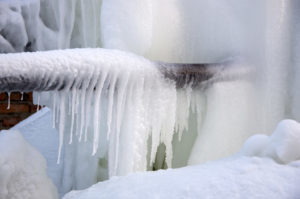You may need more than bread and milk on hand if the meteorological phenomenon known as Winter Storm Grayson turns out to be as intense as anticipated. The Weather Channel predicts that Grayson may bring the East Coast of the U.S. some of the heaviest snow in decades and even more severe cold than we’ve seen this past week. It snowed in Tallahassee, Florida, for the first time in 28 years, if that’s any indication of things to come.

Even if you’re a northerner who’s used to winter conditions or pride yourself on wearing flip-flops in the snow, extreme cold is accompanied by a significant risk of pipes freezing. Frozen pipes can cause major issues in your home, as they prevent water flow and eventually burst, causing damage and flooding.
Here are five quick and easy tips to help you prevent losses related to frozen pipes:
Tip #1: Keep the heat on.
Make sure not to turn off the heat, even if you’re leaving the house for an extended period. It’s best to set the thermostat above 50 degrees Fahrenheit to provide enough heat to keep the pipes warm and prevent any water inside them from freezing.
Tip #2: Keep interior and cabinet doors open.
Pipes are often located in cabinets; when the temperature drops, it’s a good idea to keep cabinet doors open so the heat from the rest of the house can keep the pipes warm as well. Also, leave all interior doors open so heat can circulate throughout the home.
Tip #3: Allow faucets to drip.
If you’re afraid your pipes will freeze, you can let water drip slightly from the faucets. What causes frozen pipes to burst is the pressure created between a frozen blockage and the faucet. Allowing the faucet to drip relieves this pressure build-up and helps to keep pipes from bursting.
Tip #4: Seal up leaks.
Holes and cracks—especially those located near pipes—on both interior and exterior walls should be sealed up. This helps to keep the cold air out and the warm air in.
Tip #5: Add extra insulation.
If you’ve ever had problems with frozen pipes anywhere in your home, extra insulation could be the cure. Pipes can be fitted with foam rubber or fiberglass sleeves to decrease their chances of freezing. This is an easy solution for pipes that are exposed, but it can get expensive if walls, floors or ceilings must be opened to properly insulate the pipes.
Pipes found in areas like basements and attics are likely to need extra insulation to keep them from freezing. Supplementary insulation can also be added to walls and ceilings to keep pipes there warm.
In the event you do suffer damage to your home or business due to frozen pipes, Vericlaim Repair Solutions will be there to help you through the restoration process. In the meantime, we hope you’re safe and warm and have plenty of milk and bread to hold you over.
--Ed Reis, president, Vericlaim Repair Solutions, a Sedgwick company